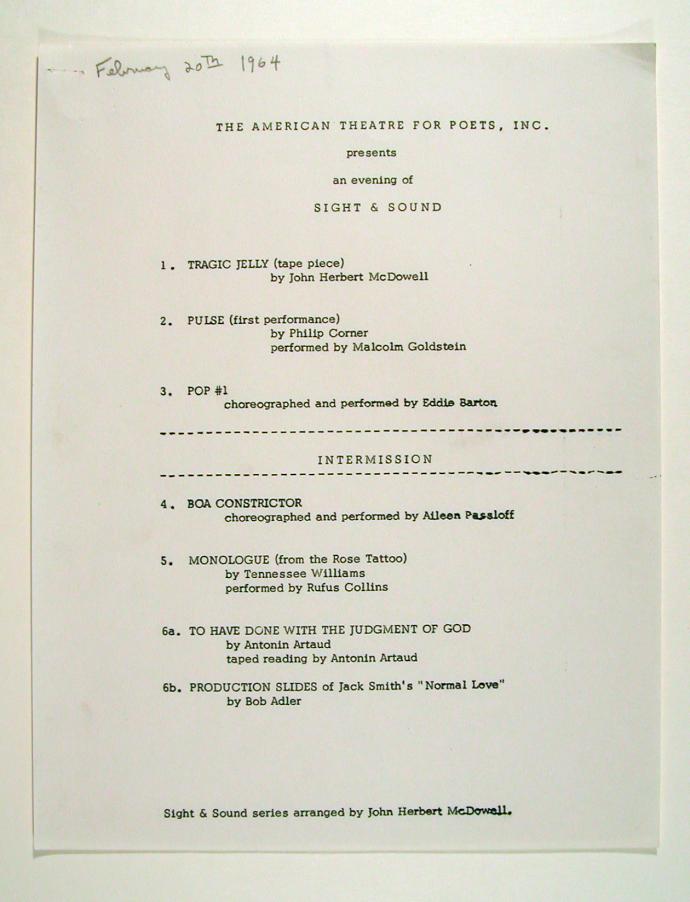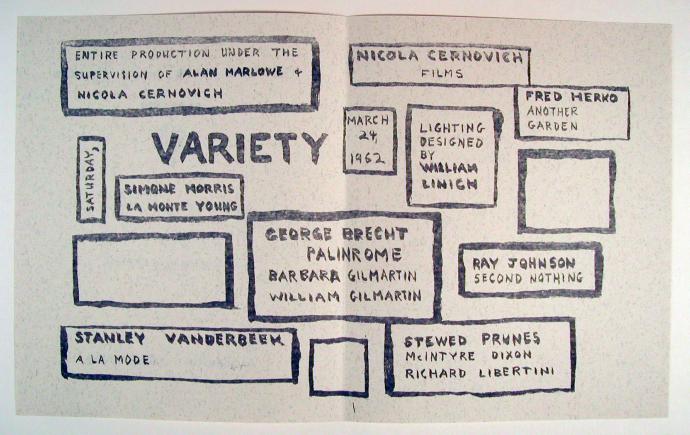from pastelegram.org, June 2011 – April 2014
Creating Context
If you have ever engaged in archival research, chances are you know that particular feeling of information overload—of realizing that the world you are peeking into is more vast and complex than you could ever hope to comprehend. Perhaps you look for answers to one or two focused questions. When did so-and-so come up with the idea for this book? Or how did this person collaborate with that person? What you get instead are names you don’t recognize or names you know but weren’t expecting to see. Maybe you see references in letters or diaries to a dinner, a party, a gallery opening. Or better yet, you find titillating gossip. You spend hours looking through notebooks and sheaves of paper, no closer to the answers to your questions.

The American Theatre for Poets, Inc., cover of February-March 1965 program for "One-Act Plays by American Poets," at the East End Theatre; image courtesy of the Harry Ransom Center, University of Texas at Austin.
The central project of "There Is No Taste in Theatre: It Is a Medium" is an online database of every event produced by the American Theatre for Poets (also known as the New York Poets Theatre) between 1961 and 1965 and every person who participated in it. It approaches a small collection of archival materials—not to find answers to particular questions, but instead to resist interpretation in favor of description.1 The conceptual approach to the database project is akin to how Heather Love discusses description and surface reading, or what she calls “close but not deep” reading:
Good descriptions are in a sense rich, but not because they truck with imponderables like human experience or human nature. They are close, but they are not deep; rather than adding anything “extra” to the description, they account for the real variety that is already there.2
Love holds that the history one derives from looking at a text or an object or a collection looks different if one approaches it from a place of description instead of interpretation. To look at the surface of things does not necessarily entail a denial of complexity, but it may require a certain refusal to read a deeper meaning or a motive into them. Perhaps this sounds cold. But what is gained from such an approach is an ability to discern wide swaths—people moving in and out of a space, in and out of one another’s lives, creating and moving on, over a long period of time, without ascribing to their actions any sort of earth-shaking import or catastrophic rupture. The advantage of this broad horizontal view is that it affords historians a way to think about history as something workaday and quotidian, as an exchange of ideas rather than as a genealogy of influence.

The American Theatre for Poets, Inc., flyer for "An Evening of Sight & Sound," organized by John Herbert Macdowell, February 20, 1964; image courtesy the Harry Ransom Center, University of Texas at Austin.
Many of the programs and flyers from the American Theatre for Poets read like bills from a variety show. One prominent example is the series Sights and Sounds, which entailed five different programs over a period of four weeks in 1964 at the New Bowery Theatre. Included were performances of music, dance, theater, film and spoken word, or some combination of these—often four or five in a single evening.3 Another earlier performance was simply entitled "Variety," and included a film by Stan Vanderbeek, improv by the duo The Stewed Prunes, a performance by Ray Johnson and George Brecht, and music by Simone Forti (then Simone Morris) and La Monte Young. Naturally, because of all this activity, a large number of people participated in the American Theatre for Poets over the years. With such a sprawling inclusion of media, styles and performers, the events that the American Theatre for Poets produced during its four sporadic years called for a descriptive approach to make sense of the company’s historical import.
The New York Poets Theatre Records—the archive that provided the data for this project—was the first collection that I ever cataloged. I was an intern at the Harry Ransom Center, and I was finishing my graduate studies in art history. I mention this because cataloging involves in many ways a process of thinking that is antithetical to the way most academics in the humanities work. The latter often spend a lot of time thinking about what is not present in a work of art or literature: what was left out, what we can learn from comparing this work of art to others. When we describe an artwork in writing, it is almost always in service of looking at the work as a thing that represents larger cultural ideas and trends. The purpose of description in cataloging, by contrast, is not to interpret—not to draw comparisons between objects or to conjecture about their use or their importance relative to another object. A cataloger’s main goal is to describe each object as accurately and objectively as possible.4 It is to create a resource for researchers, who then use the catalogers’ inventories to decide how to arrange their own thoughts, how to find what they need. The cataloger gives shape to an archive that would otherwise appear in disarray.

The American Theatre for Poets, Inc., program for "Variety," March 24, 1962; image courtesy the Harry Ransom Center, University of Texas at Austin.
When I set out to catalog the New York Poets Theatre Records, I wasn’t prepared for such objective thought. During my initial survey of the avalanche of names and dates that appeared on the dozens of flyers and programs, my first instincts relied on my previous academic training. I focused on a few names and then attempted to fit them into a familiar narrative of the downtown New York art world of the era. For instance, the 1964 seizure of Jack Smith’s film Flaming Creatures occurred in the New Bowery Theatre; the Poets Theatre shared the building with the Filmmakers Cinematheque, which was responsible for the controversial screening. Smith’s name appears repeatedly in the New York Poets Theatre Records: as a costume designer for a play by Frank O’Hara, as the subject of a slide show by Bob Adler of stills from Smith’s film Normal Love, and as the artist whose photographs were on display in the lobby of the Off Bowery Theatre. Similarly, the dancer Fred Herko, whose legendary and balletic suicide punctuates several histories of the New York avant-garde, appears over and over in the programs. Besides Herko, other members of the Andy Warhol Factory crowd litter the archive: Rufus Collins, William Linich (or Billy Name, as he is now known), Alan Marlowe, John Palmer. Warhol appears too. As I spent more time with the archive, though, I realized that what interested me most about the American Theatre for Poets was not the events, or even the presence of prominent participants. Rather, no single performer or even series of events emerged as the focus of the company. Even those participants who established successful and well-publicized careers didn't stand out in the flyers and programs. Their names weren’t writ large; their fate wasn’t pre-ordained. The company’s future, as the events it produced unfolded, was more indistinct, its outcomes less well-defined.
As I got more used to cataloging—to reading the surface of the materials for the information on the page, rather than how that information fit into a specific context—I became aware of a sonorous incongruity between the modes of cataloging and of historicizing. The two, I realized, could work in tandem. In the case of the New York Poets Theatre Records, I decided to use techniques borrowed from cataloging to create a comprehensive, descriptive history of the theater company. In short, I was creating context out of the materials rather than contextualizing them according to an already extant history. The database is in many ways an ideal vehicle for realizing that goal. For one thing, it is impossible to include details about the activities of the American Theatre for Poets while constrained by a narrative format. The medium of the database, with its programmable lists and capabilities for organizing information according to multiple categories—Venue, Participant, Event—allows for an elegance through repetition that would be too cumbersome using traditional modes of writing.
There is little room for hierarchical structure in an approach that levels all names and events to the status of descriptive data. It’s difficult to say which of the American Theatre for Poets’ productions were more successful than others or whose performance outshone whose or which events have come to stand in for the significance of the company as a whole. Sometimes though, telling a story one paragraph after another, in clearly constructed sentences, can really hinder the understanding of something. Ultimately, the description that the database encourages can open the doors to a history that embraces the information overload inherent in any extended period of engagement with an archive, rather than jettisoning it to the background.
This article is part of "There Is No Taste in Theatre: It is a Medium," edited by Chelsea Weathers. Other parts of this project include:
A Partial Index of the American Theatre for Poets, Inc., 1961–1965
Creating Context by Chelsea Weathers
An interview with Aileen Passloff by Robin Williams
Theatre Quote Unquote:* The Expansive Gestures of the New York Poets Theatre (American Theatre for Poets, Inc.) by Leanne Gilbertson
Reading Frank O’Hara’s Loves Labor: an eclogue, an elegy for the New York Poets Theatre by Cameron Williams
and our editor's statement
- 1. Every participant’s name is included, every role accounted for and every event represented, at least to the extent provided by the materials available. In this way, the database is, ultimately, a record of the materials in the archive and not necessarily a record of what actually happened. There is, admittedly, a disconnect there, which is inherent in any history that relies on archival resources for its content.
- 2. Heather Love, “Close but not Deep: Literary Ethics and the Descriptive Turn,” New Literary History 41 no. 2 (Spring 2010): 377. For more on the subject, see Stephen Best and Sharon Marcus, “Surface Reading: An Introduction,” Representations 108 no. 1 (Fall 2009): 1-21; and Franco Moretti, Distant Reading (New York: Verso, 2013).
- 3. Such catholic programming reflects similar approaches to art and performance taking place across downtown New York in the early 1960s, such as the activities of the Judson Dance Theater and the Living Theatre—two organizations whose members also included participants in the American Theatre for Poets.
- 4. There are several books available to aid in decisions about naming and description, and they all go by various acronyms: CCO (Cataloging Cultural Objects), AAT (Art and Architecture Thesaurus), DCRM (Descriptive Cataloging of Rare Materials), to name a few. The purpose of these volumes is to provide a clear and concise system for naming and describing every physical aspect of any type of object, from a manuscript to a photograph to a pair of gloves, and to maintain consistent language across an array of similar objects.